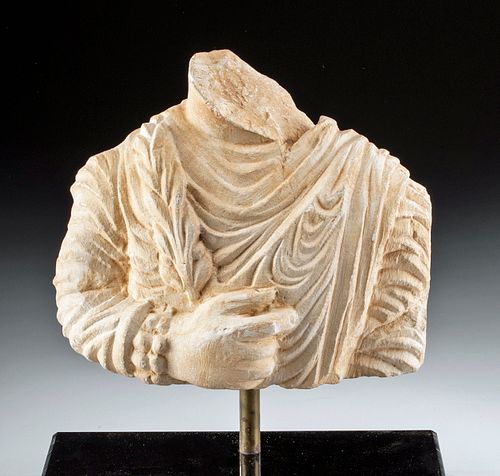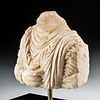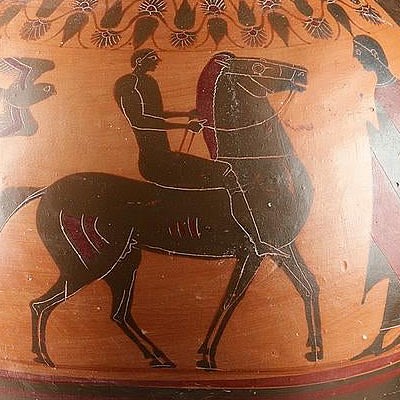Roman Limestone Bust - Draped Figure w/ Feather
Lot 96a
About Seller
Artemis Fine Arts
686 S Taylor Ave, Ste 106
Louisville, CO 80027
United States
Selling antiquities, ancient and ethnographic art online since 1993, Artemis Gallery specializes in Classical Antiquities (Egyptian, Greek, Roman, Near Eastern), Asian, Pre-Columbian, African / Tribal / Oceanographic art. Our extensive inventory includes pottery, stone, metal, wood, glass and textil...Read more
Categories
Estimate:
$5,000 - $7,500
Absentee vs Live bid
Two ways to bid:
- Leave a max absentee bid and the platform will bid on your behalf up to your maximum bid during the live auction.
- Bid live during the auction and your bids will be submitted real-time to the auctioneer.
Bid Increments
| Price | Bid Increment |
|---|---|
| $0 | $25 |
| $300 | $50 |
| $1,000 | $100 |
| $2,000 | $250 |
| $5,000 | $500 |
| $10,000 | $1,000 |
| $20,000 | $2,500 |
| $50,000 | $5,000 |
| $100,000 | $10,000 |
| $200,000 | $20,000 |
About Auction
By Artemis Fine Arts
Jun 4, 2020
Set Reminder
2020-06-04 10:00:00
2020-06-04 10:00:00
America/New_York
Bidsquare
Bidsquare : Exceptional Antiquities, Asian, Ethnographic
https://www.bidsquare.com/auctions/artemis-gallery/exceptional-antiquities-asian-ethnographic-5185
An important one-day auction featuring museum-worthy examples of Egyptian, Greek, Roman, Etruscan, Near Eastern, Far East / Asian, Pre-Columbian, African / Tribal, Oceanic, Native American, Spanish Colonial, Russian, Fossils, Ancient Jewelry, Fine Art, so much more! Artemis Fine Arts info@artemisgallery.com
An important one-day auction featuring museum-worthy examples of Egyptian, Greek, Roman, Etruscan, Near Eastern, Far East / Asian, Pre-Columbian, African / Tribal, Oceanic, Native American, Spanish Colonial, Russian, Fossils, Ancient Jewelry, Fine Art, so much more! Artemis Fine Arts info@artemisgallery.com
- Lot Description
Near East/Holy Land, Palmyra, Roman period, ca. 2nd to 3rd century CE. A high relief funerary bust, hand-carved from limestone, depicting a cloaked figure with thick folds of fabric draping over the chest and arms. One hand is presented in high relief before his chest with a double strand beaded bracelet and holding a lovely feather. Size: 6.7" W x 6" H (17 cm x 15.2 cm); 8.2" H (20.8 cm) on included custom stand.
Palmyra was a wealthy city that linked the caravan routes from the Parthian Near East with the Roman Mediterranean; the people who lived there during this period largely enjoyed prosperity and were able to adopt eastern and western customs, clothing, and artistic styles, creating a distinctive visual culture unique to the city. We know of this culture today from the large funerary monuments that the Palmyrans built - tower-shaped vaults whose interiors were lined with sculpted limestone reliefs depicting the deceased.
Provenance: ex-Phoenicia Holyland Antiquities; ex Edgar L. Owen. Auction catalogue 32, April 17, 1997, lot # 355
All items legal to buy/sell under U.S. Statute covering cultural patrimony Code 2600, CHAPTER 14, and are guaranteed to be as described or your money back.
A Certificate of Authenticity will accompany all winning bids.
We ship worldwide and handle all shipping in-house for your convenience.
#155755Piece is a fragment from a larger sculpture as shown, with the head lost (the lower body was never part of this sculpture; it ends below the arm). The neck is slightly rough. The figure has also been drilled into on its lower side to accommodate a stand. Small scratches, chips, and nicks commensurate with age. Great preservation of details and form.Condition
- Shipping Info
-
All shipping is handled in-house for your convenience. Your invoice from Artemis Gallery will include shipping calculation instructions. If in doubt, please inquire BEFORE bidding for estimated shipping costs for individual items.
-
- Buyer's Premium



 EUR
EUR CAD
CAD AUD
AUD GBP
GBP MXN
MXN HKD
HKD CNY
CNY MYR
MYR SEK
SEK SGD
SGD CHF
CHF THB
THB














